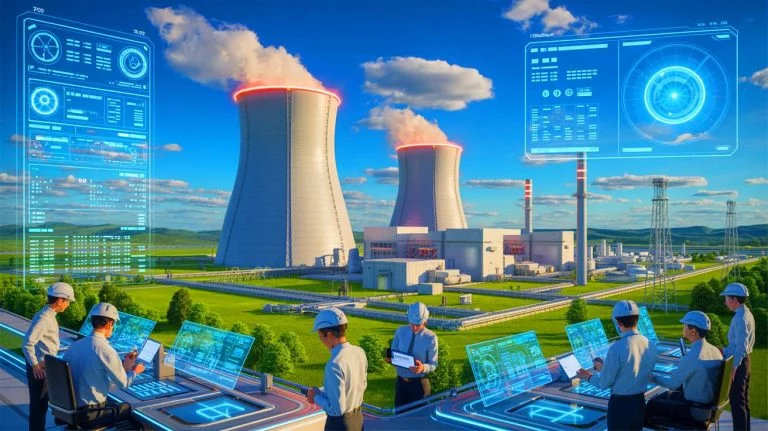| IN A NUTSHELL |
|
The United States is taking a bold step in nuclear energy innovation, leveraging the power of artificial intelligence (AI) to transform how nuclear reactors are designed and operated. The Idaho National Laboratory (INL) has partnered with Amazon Web Services (AWS) to develop autonomous nuclear systems. This collaboration aims to create digital twins of nuclear reactors using AWS’s advanced cloud technology. The move is part of a larger effort to modernize the nuclear energy sector, which has historically faced challenges such as high costs and regulatory hurdles.
Digital Twins: A Groundbreaking Approach
The concept of digital twins is at the heart of this initiative. Digital twins are virtual replicas of physical systems that enable detailed modeling and simulation. By utilizing AWS’s cloud infrastructure, INL aims to create digital twins of small modular reactors (SMRs). These reactors, with capacities ranging from 20 to 300 megawatts, are poised to benefit from AI-driven efficiencies.
John Wagner, Director of INL, highlighted the significance of this collaboration, stating that it marks a leap forward in integrating AI with nuclear energy research. “Our collaboration with Amazon Web Services marks a significant leap forward in integrating advanced AI technologies into our nuclear energy research and development initiatives,” Wagner noted. The partnership underscores the critical role of linking the nation’s nuclear energy laboratory with AWS to accelerate nuclear energy deployment.
By using real-time data, these digital twins will enhance modeling capabilities, facilitate simulations, and eventually allow for safe autonomous operations. This initiative is expected to revolutionize how nuclear plants are built and operated, offering potential cost reductions and improved safety.
Harnessing the Power of Machine Learning
As part of INL’s broader vision, the integration of machine learning with nuclear technology aims to create an AI-nuclear ecosystem. This ecosystem will connect Department of Energy (DOE) labs, tech companies, and energy developers. The ultimate goal is to develop nuclear reactors that are not only faster to construct but also safer and more intelligent in operation.
The INL-AWS partnership follows a similar collaboration between Westinghouse and Google Cloud, highlighting the growing importance of AI in the nuclear sector. By combining AI platforms with proprietary nuclear data, these partnerships aim to accelerate the development of advanced nuclear technologies.
In May 2025, President Donald Trump signed executive orders to streamline reactor permitting and expand domestic nuclear fuel production. These efforts are part of a broader strategy to modernize the U.S. nuclear energy infrastructure and support increasing AI-driven power demands.
A National Push for AI-Driven Nuclear Power
The U.S. government has recognized the critical role of nuclear energy in maintaining technological competitiveness and supporting future data center growth. The release of a national AI Action Plan in July 2025 identified reliable, dispatchable energy, including nuclear power, as essential components of this strategy.
The partnership between INL and AWS is a reflection of this national push. By leveraging customized chips like Inferentia and Trainium, along with tools such as Amazon SageMaker, the collaboration aims to drive the adoption of AI in nuclear applications. Chris Ritter, division director of Scientific Computing and AI at INL, emphasized the importance of this partnership in accessing AI models and specialized cloud services.
This initiative is not just about technological advancements; it is also about redefining the future of energy production. By embracing AI, the U.S. is positioning itself at the forefront of global nuclear innovation.
The Road Ahead for AI and Nuclear Energy
While the potential benefits of AI-driven nuclear energy are immense, the path forward is not without challenges. The integration of AI into nuclear systems requires careful consideration of safety protocols, regulatory compliance, and public acceptance. However, the collaboration between INL and AWS is a promising step toward overcoming these hurdles.
As the U.S. continues to invest in AI-driven nuclear technologies, the focus will be on creating a sustainable and secure energy future. The development of autonomous reactors and digital twins represents a significant shift in how nuclear energy is perceived and utilized.
The question remains: How will this transformation in nuclear energy impact global energy dynamics, and what role will AI play in shaping the future of sustainable power?
Did you like it? 4.6/5 (22)








Wow, AI and nuclear power? That’s a powerful combo! 🔥
Is it safe to rely so heavily on AI for something as critical as nuclear energy?
I’m excited to see how this partnership will reduce the cost of nuclear energy. 🙌
Why is Amazon involved in nuclear tech, though? Aren’t they a bit out of their depth here? 🤔
Thank you for the detailed article! Can’t wait to see these smart reactors in action.
Does this mean we’ll have mini nuclear reactors in our backyards soon?
AI-driven efficiencies sound great, but what about cybersecurity risks?
This seems like a huge leap for nuclear energy. Kudos to everyone involved! 🌟
Are there any other countries working on similar AI-nuclear projects?
How will this affect jobs in the nuclear sector? Will there be more automation?